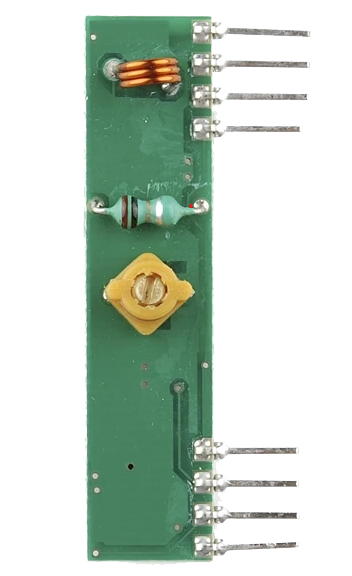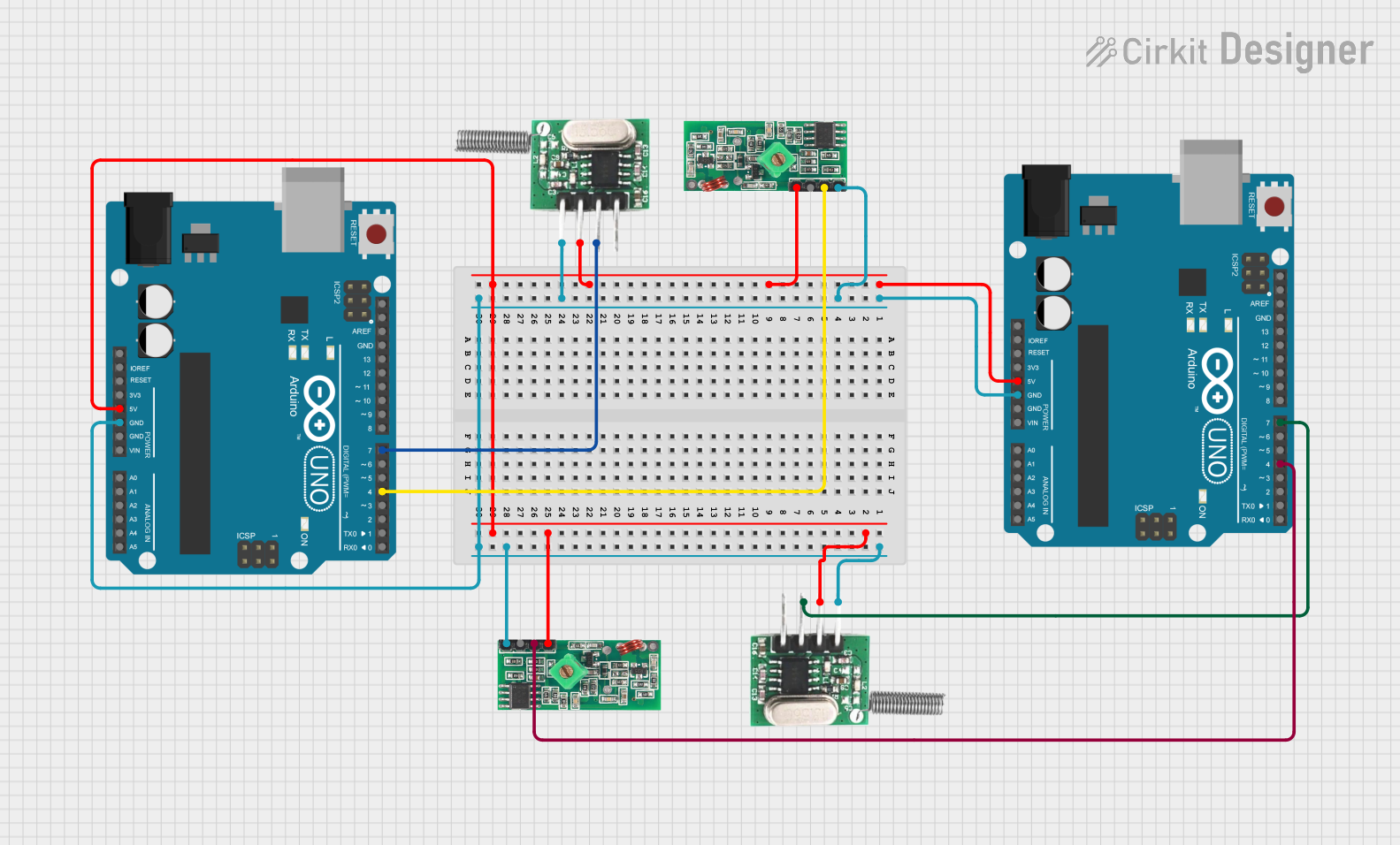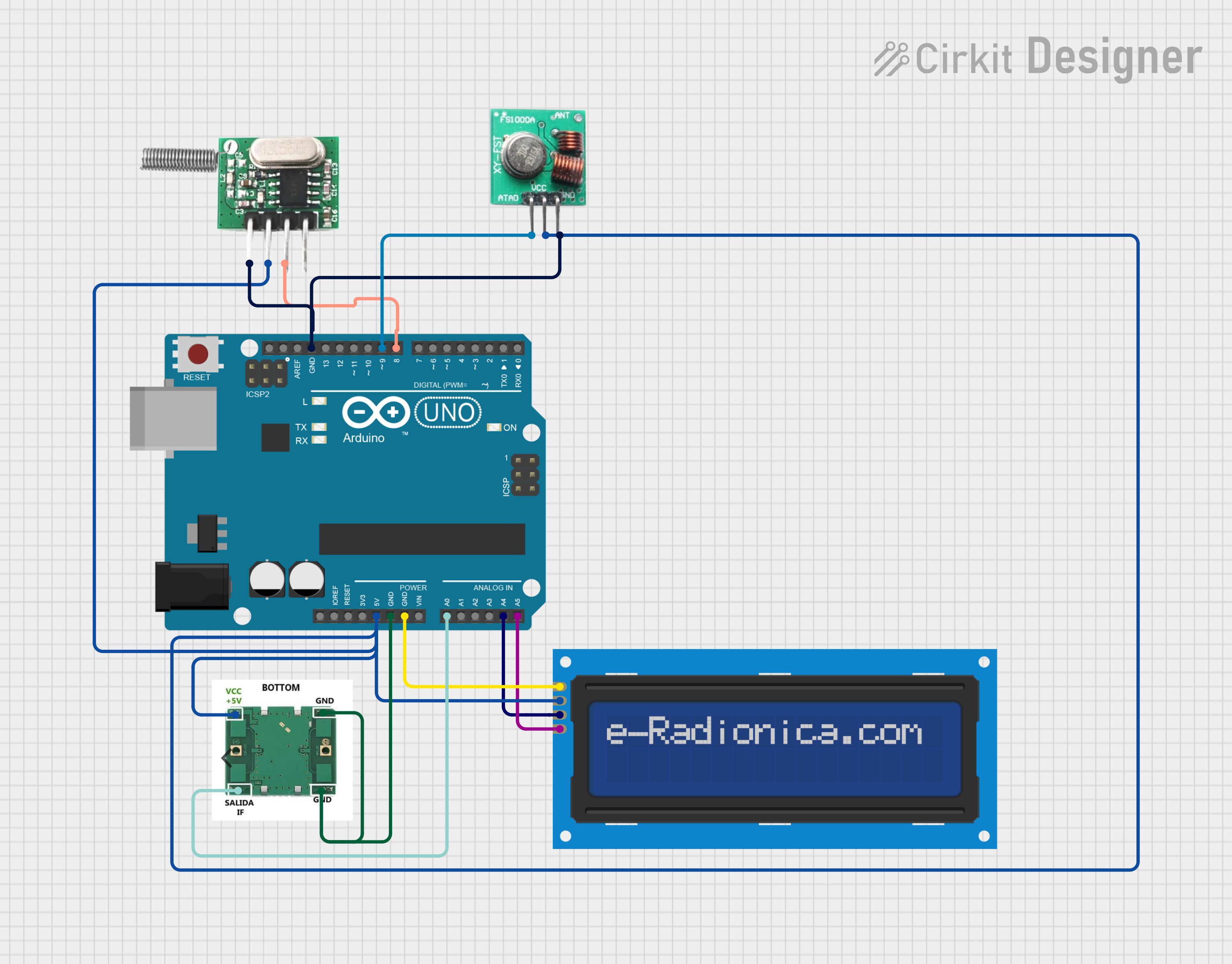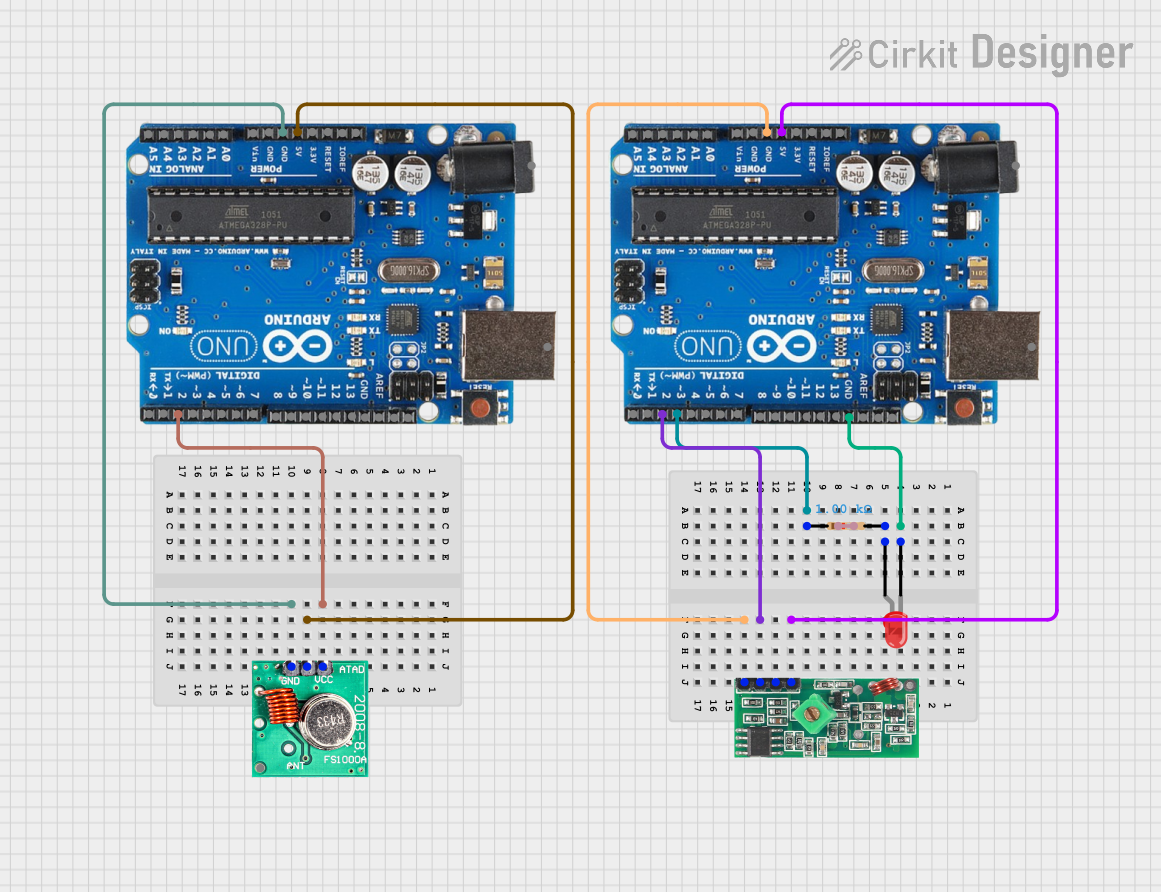
How to Use RF Link Receiver - 4800bps (434MHz): Examples, Pinouts, and Specs

 Design with RF Link Receiver - 4800bps (434MHz) in Cirkit Designer
Design with RF Link Receiver - 4800bps (434MHz) in Cirkit DesignerIntroduction
The RF Link Receiver - 4800bps (434MHz), manufactured by WENSHING, is a compact and efficient radio frequency receiver module. It is designed to receive data signals at a baud rate of 4800 bps and operates at a frequency of 434 MHz. This module is widely used in wireless communication systems for transmitting and receiving data over short to medium distances.
Explore Projects Built with RF Link Receiver - 4800bps (434MHz)

 Open Project in Cirkit Designer
Open Project in Cirkit Designer
 Open Project in Cirkit Designer
Open Project in Cirkit Designer
 Open Project in Cirkit Designer
Open Project in Cirkit Designer
 Open Project in Cirkit Designer
Open Project in Cirkit DesignerExplore Projects Built with RF Link Receiver - 4800bps (434MHz)

 Open Project in Cirkit Designer
Open Project in Cirkit Designer
 Open Project in Cirkit Designer
Open Project in Cirkit Designer
 Open Project in Cirkit Designer
Open Project in Cirkit Designer
 Open Project in Cirkit Designer
Open Project in Cirkit DesignerCommon Applications and Use Cases
- Wireless remote controls (e.g., garage doors, home automation)
- Data transmission in IoT devices
- Wireless sensor networks
- Robotics and remote monitoring systems
- RF-based communication between microcontrollers
Technical Specifications
The following table outlines the key technical details of the RF Link Receiver:
| Parameter | Value |
|---|---|
| Operating Frequency | 434 MHz |
| Baud Rate | 4800 bps |
| Operating Voltage | 5V DC |
| Operating Current | 4.5 mA (typical) |
| Sensitivity | -105 dBm |
| Communication Range | Up to 100 meters (line of sight) |
| Modulation Type | ASK (Amplitude Shift Keying) |
| Dimensions | 30mm x 14mm x 7mm |
Pin Configuration and Descriptions
The RF Link Receiver module has four pins, as described in the table below:
| Pin | Name | Description |
|---|---|---|
| 1 | GND | Ground pin. Connect to the ground of the power supply. |
| 2 | DATA | Data output pin. Outputs the received digital signal. |
| 3 | VCC | Power supply pin. Connect to a 5V DC source. |
| 4 | ANT | Antenna pin. Connect to a 17cm wire or a suitable antenna for better reception. |
Usage Instructions
How to Use the Component in a Circuit
- Power Supply: Connect the
VCCpin to a 5V DC power source and theGNDpin to the ground. - Data Output: Connect the
DATApin to the input pin of a microcontroller or a decoder IC to process the received signal. - Antenna: Attach a 17cm wire or a pre-designed antenna to the
ANTpin to improve signal reception. - Pairing with a Transmitter: Ensure that the RF Link Receiver is paired with a compatible 434 MHz RF transmitter module for proper communication.
Important Considerations and Best Practices
- Antenna Placement: For optimal performance, place the antenna in an open area, away from metal objects or other sources of interference.
- Power Supply Stability: Use a stable 5V power supply to avoid noise or signal distortion.
- Decoding the Signal: The output from the
DATApin is raw digital data. Use a microcontroller or a decoder IC to interpret the signal. - Range Limitations: The communication range is up to 100 meters in line-of-sight conditions. Obstacles like walls or interference may reduce the range.
Example: Connecting to an Arduino UNO
Below is an example of how to connect the RF Link Receiver to an Arduino UNO and read the received data:
Circuit Connections
- Connect the
VCCpin of the receiver to the 5V pin on the Arduino. - Connect the
GNDpin of the receiver to the GND pin on the Arduino. - Connect the
DATApin of the receiver to digital pin 2 on the Arduino. - Attach a 17cm wire to the
ANTpin for the antenna.
Arduino Code
// Example code to read data from the RF Link Receiver (434MHz)
// Connect the DATA pin of the receiver to digital pin 2 on the Arduino.
#define RECEIVER_PIN 2 // Pin connected to the DATA pin of the receiver
void setup() {
Serial.begin(9600); // Initialize serial communication at 9600 bps
pinMode(RECEIVER_PIN, INPUT); // Set the receiver pin as input
Serial.println("RF Receiver Ready");
}
void loop() {
int receivedData = digitalRead(RECEIVER_PIN); // Read the data from the receiver
Serial.print("Received Data: ");
Serial.println(receivedData); // Print the received data to the Serial Monitor
delay(100); // Small delay to avoid flooding the Serial Monitor
}
Troubleshooting and FAQs
Common Issues and Solutions
No Data Received:
- Ensure the transmitter and receiver are operating at the same frequency (434 MHz).
- Check the antenna connection and placement for proper signal reception.
- Verify that the
DATApin is correctly connected to the microcontroller.
Short Communication Range:
- Use a longer or properly tuned antenna for better reception.
- Minimize obstacles and interference between the transmitter and receiver.
Unstable or Noisy Output:
- Use a decoupling capacitor (e.g., 0.1µF) across the power supply pins to reduce noise.
- Ensure a stable 5V power supply is used.
Interference from Other Devices:
- Avoid using the module near devices operating at the same frequency (e.g., other 434 MHz devices).
- Use proper shielding or filters to minimize interference.
FAQs
Q1: Can I use this module with a 3.3V microcontroller?
A1: The module requires a 5V power supply. However, the DATA pin output can often be read by 3.3V logic microcontrollers. Use a level shifter if needed.
Q2: What type of antenna should I use?
A2: A simple 17cm wire works well as an antenna. For better performance, you can use a pre-designed 434 MHz antenna.
Q3: Can this module be used for bi-directional communication?
A3: No, this module is a receiver only. For bi-directional communication, pair it with a compatible RF transmitter module.
Q4: What is the maximum baud rate supported?
A4: The module supports a maximum baud rate of 4800 bps. Ensure the transmitter is configured to the same baud rate.